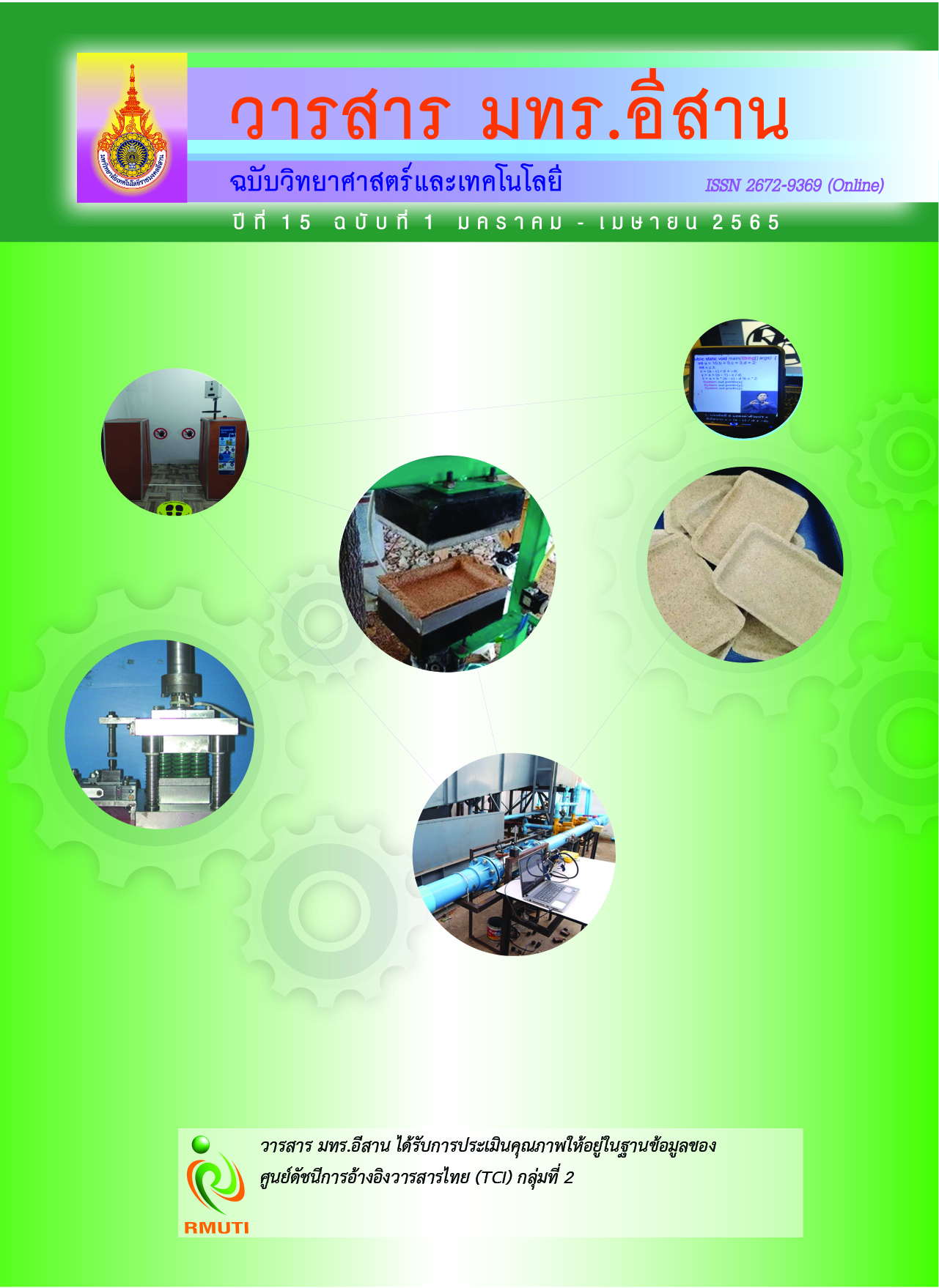การออกแบบและพัฒนาประตูอัจฉริยะเพื่อคัดกรองบุคคลด้วยระบบอัตโนมัติ
Main Article Content
บทคัดย่อ
งานวิจัยนี้มีวัตถุประสงค์เพื่อการออกแบบและพัฒนาประตูอัจฉริยะเพื่อคัดกรองบุคคลด้วยระบบอัตโนมัติการศึกษาครั้งนี้คณะผู้จัดทำได้ทำการออกแบบระบบให้ทำงานตามเงื่อนไข 3 ขั้นตอน คือ 1) ตรวจจับการใส่หน้ากากอนามัย 2) ตรวจวัดอุณหภูมิของร่างกาย และ 3) พ่นสเปรย์แอลกอฮอล์เพื่อทำความสะอาดมือเมื่อผู้ใช้บริการผ่านการตรวจสอบทั้ง 3 ขั้นตอน ประตูจะเปิดเพื่อให้ผู้ใช้บริการผ่านได้ ซึ่งประตูอัจฉริยะนี้ควบคุมการทำงานด้วยบอร์ด Corgidude และบอร์ด Arduino ร่วมกับเซ็นเซอร์ตรวจจับหน้ากากอนามัยตรวจวัดอุณหภูมิ และจ่ายสเปรย์พ่นแอลกอฮอล์ ผลจากการทดสอบพบว่า ประตูอัจฉริยะเพื่อคัดกรองบุคคลด้วยระบบอัตโนมัติ สามารถทำการคัดกรองบุคคลได้ 3 ขั้นตอนตามเงื่อนไขที่กำหนดไว้ ใช้เวลาในการทำงานโดยเฉลี่ย 7.66 วินาทีต่อคน หรือสามารถคัดกรองบุคคลได้สูงสุด 470 คนต่อชั่วโมง เมื่อมีการทำงานต่อเนื่องและมีการใช้พลังงานไฟฟ้า 7.476 × 10-3 กิโลวัตต์-ชั่วโมง หรือเท่ากับ 0.0243 บาทต่อชั่วโมง
Article Details

อนุญาตภายใต้เงื่อนไข Creative Commons Attribution-NonCommercial-NoDerivatives 4.0 International License.
เอกสารอ้างอิง
Department of Disease Control. (2019). Guidelines for the Prevention and Control of Coronavirus Disease 2019 in Schools and Educational Institutions. Access (5 May 2021). Available (https://ddc.moph.go.th)
Kruawan, N., Krakhunthod, N., Talatkwan, N., and Kongsang, J. (2018). The Operation of a Microcontroller System Works with an In-Depth Analytical Processing System. Vocational Project Satuk Vocational College
Kaenphet, T. (2012). Face-to-Face Online Performance Recording System. M. Eng. Computer Engineering Rajamangala University of Technology Thanyaburi
Loylom, C. (2017). Industrial Mechanical Arm Simulation Set. M. Eng. Electrical Engineering Burapha University
Maker Asia. (2562). Corgidude Board. Access (15 May 2021). Available (https://corgidude.makerasia.com)
Phurak, T. (2015). Display with LCD Display. Documents for Teaching Basic Arduino Courses, Saraburi: Saraburi Technical College
Wisetkaew, W. (2018). Display with LCD Display. Teaching Documents for Microcontroller Course. Yasothon Technical College
Maneetham, D. (2015). Arduino Board. Bangkok: SE-Education Public Company Limited
Analog Read. (2562). Infrared Temperature Sensor MLX90614ESF. Access (20 May 2021). Available (https://www.analogread.com)
Supremelines. (2562). Capacitive Proximity Sensor. Access (15 May 2021). Available (https://www.supremelines.co.th)
Kamchomphu, S. (1999). Elements of Switching Power Supply. Journal of Electronic Semiconductors. Vol. 202, pp. 137-146
Cybertice. (2559). Ultrasonic Module hc-sr04. Access (15 May 2021). Avialable (https://www.cybertice.com)
Including Car, Motorcycles, Other Vehicles. (2013). Wiper System. Access (15 May 2021). Available (https://www.auto2drive.com)
Ung Phakorn, W. and Thanadngan, C. (1998). Machine Design I. Bangkok: SE-Education Public Company Limited
Ung Phakorn, W. and Thanadngan, C. (2013). Machine Design II. Bangkok: SE-Education Public Company Limited
Norton, R. L. (2009). Kinematics and Dynamics of Machinery. 1st Edition (SI unit). McGraw-Hill
Mekhphuksawong, P. and Pheimchat, W. (2000). Pumps in Engineering. 1st Edition. Bangkok: King Mongkut's Institute of Technology Ladkrabang


